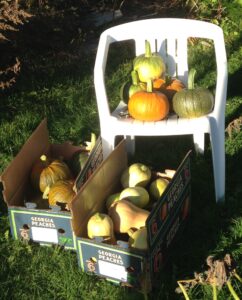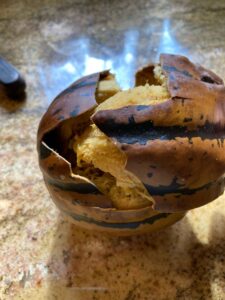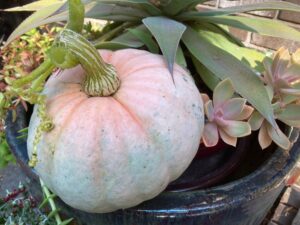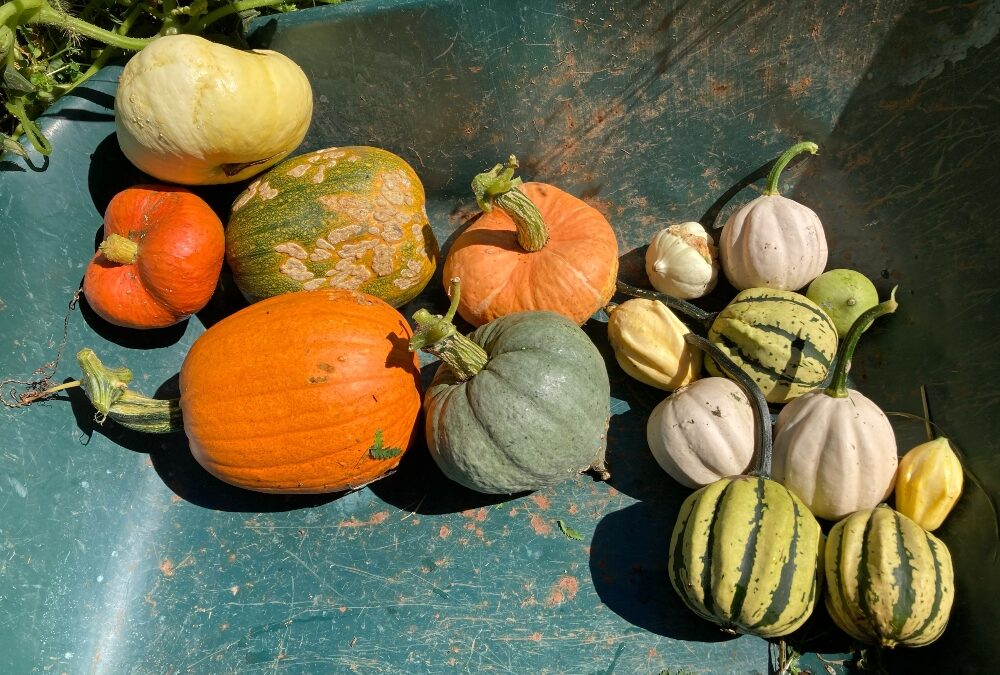Growing food – to save money, to eat locally, to slow down my hectic life through contact with nature – has been a lifelong passion of mine. Moving to16 rural acres in Wisconsin allowed me to scale up food production and opportunities to be with nature.
Saving seeds brought my food production closer to zero waste.
It works well for beans, peas, tomatoes. Potatoes were easy to seed with last years’ sprouting specimens. Below is my 2016 pie pumpkins and butternut squash grown from saved seeds.

Last year I branched out adding some seeds from our 2 favorites – kabocha squash and cinderella (warty, pale peach color) pumpkins. The 6 varieties from the left of the feature photo came from from my saved seeds. The typical pumpkin-shaped specimens have proven to be classic pie pumpkin on the inside despite the warty skin. Three squashes with trifold symmetry yet different colors all approach butternut in taste, but less firm in texture. Lastly, the green turban that comes to a point, vaguely resembling a kabocha squash, will hopefully have the velvety texture and gentle sweetness of the Japanese parent.
Not a single squash resembles the parent squash!
I shared my seed saving adventure with my Amish friend Laverne, “Most of the seeds I use are hybrids. You probably got the split of those hybrids.” Also notable was the far-reduced bounty this year (the green wheel barrow holds all the squash we have this year) compared to my 2016 crop (over 30 fruits). And… very few male pollen-bearing flowers. The link above gives a clue to the pollen paucity… and far more information than most readers should consume!
Squashes to the right are from the compost pile, where I likely tossed delicata squash, possibly a white pumpkin as well as classic pie pumpkin seeds. Hopeful for something edible from the compost volunteers, I wagered that the delicata stripes would portend good food. Taking a literal stab at it without so much as a scratch to the surface, the roast-then-peel method I used for a 10-pound Hubbard squash years ago would soften the skin into compliance… not a chance. My delicata – wannabe was browning to a crisp texture.
Tough one to crack…
 It took a whack on my granite counter. Opened like a hard boiled egg, similar contents. Heading back to the compost pile with this failure, I chewed a small morsel. “Avocado?” Back at the house, chopped and mixed with lime and salsa to create…
It took a whack on my granite counter. Opened like a hard boiled egg, similar contents. Heading back to the compost pile with this failure, I chewed a small morsel. “Avocado?” Back at the house, chopped and mixed with lime and salsa to create…
Squashamole?
Somewhat flavorful, but not worth a recipe, nor repetition! Here is late-arriving #7: a cinderella pumpkin color but no warts! So much for squash seed saving.

I will try a second generation from this seed collection. Little clarification, but hopefully inspiration, around seed saving.
Photos by SAM Steiner 2016, 2022


